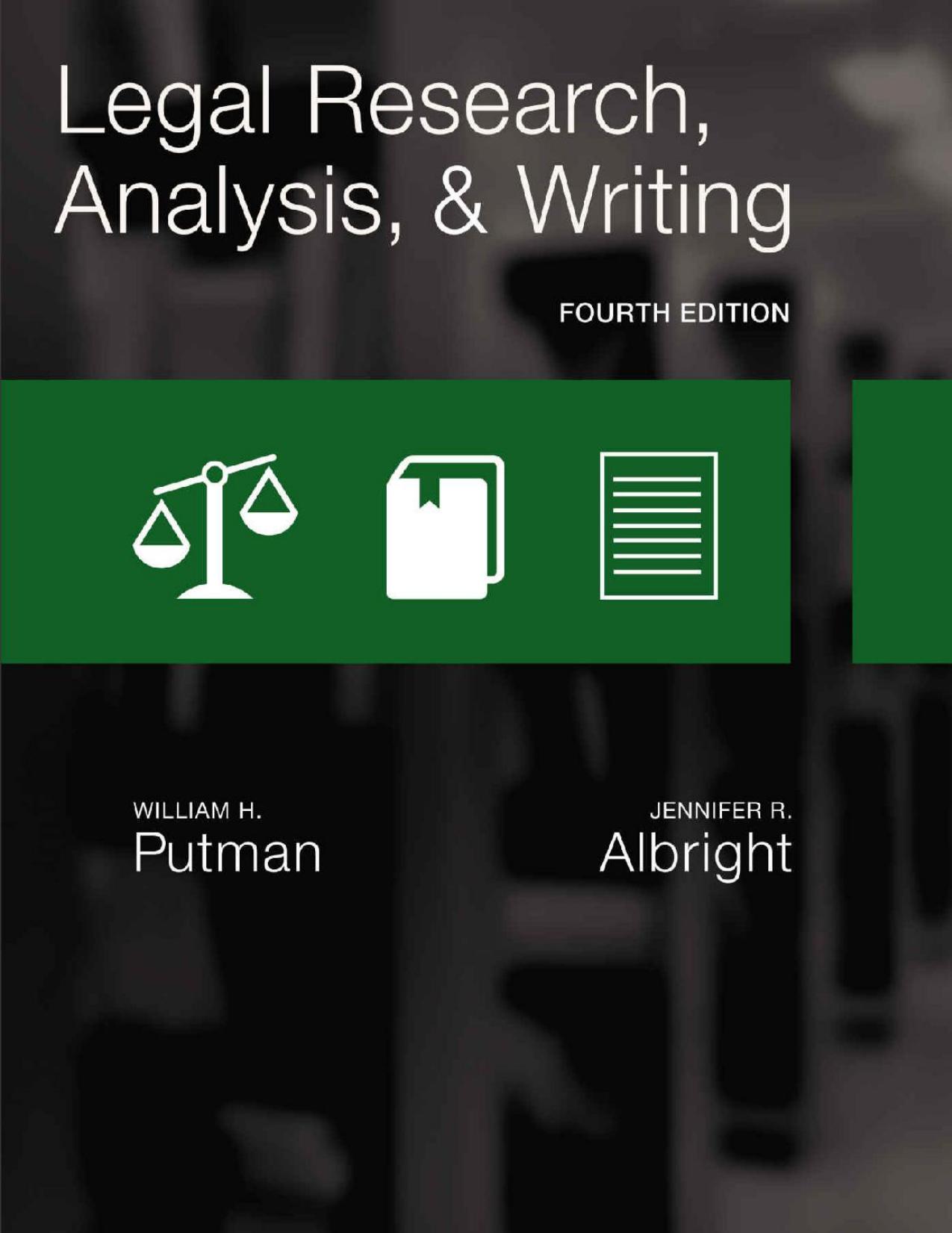Legal Research Analysis and Writing 4th Edition William Putman, Jennifer Albright ISBN 1305948378 9798214347554
$70.00 Original price was: $70.00.$35.00Current price is: $35.00.
Instant download Legal Research Analysis and Writing 4th after payment
Legal Research Analysis and Writing 4th Edition by H. Putman, Jennifer Albright – Ebook PDF Instant Download/Delivery: 1305948378, 9798214347554
Full dowload Legal Research Analysis and Writing 4th Edition after payment

Product details:
ISBN 10: 1305948378
ISBN 13: 9798214347554
Author: H. Putman, Jennifer Albright
Designed to prepare future paralegals for careers in law, LEGAL RESEARCH, ANALYSIS, AND WRITING, Fourth Edition delivers the basics in an easy-to-read, systematic manner. Following a review of the legal process, chapters walk through key facts and issue spotting, analysis and counteranalysis, traditional and online research, secondary authorities and citating, writing briefs and memoranda, and techniques for good legal writing. And, of course, the fourth edition includes the latest updates from the field—with special attention to electronic research methods using fee-based and other tools—to help paralegals stand out in a tech-driven job market.
Legal Research Analysis and Writing 4th Table of contents:
Part 1. Introduction to Research, Analytical Principles, and the Legal Process
Chapter 1. Introduction to Legal Principles and Authorities
I. Introduction
II. Sources of Law
A. Enacted Law
B. . Common Law or Case Law
III. Hierarchy of the Law
IV. Authority
A. Types of Authority
B. Role of Authority
V. Introduction to Legal Citation
A. The Bluebook: A Uniform System of Citation (The Bluebook)
B. The ALWD Guide to Legal Citation (ALWD Guide)
VI. Key Points Checklist: Legal Principles and Authorities
VII. Application
Identify and Separate Primary Authority and Secondary Authority. Step 1.
Summary
Quick References
Internet Resources
Exercises
Chapter 2. Introduction to Legal Research and Analysis
I. Introduction
II. Legal Analysis Defined
III. Legal Research and the Analysis Process
A. Facts and Key Terms
B. Preliminary Research
C. IRAC Analysis
IV. General Considerations
A. Focus
B. Ethics—Intellectual Honesty
C. When to Stop Researching
V. Key Points Checklist: Legal Research and Analysis
VI. Application
A. Battery Issue
B. Intentional Infliction of Emotional Distress Issue
Summary
Quick References
Internet Resources
Exercises
Part 2. Legal Research
Chapter 3. Constitutions, Statutes, Administrative Law, and Court Rules—Research and Analysis
I. Introduction
II. Anatomy of a Statute
A. Numbers
B. Short Title
C. Purpose Clause
D. Scope
E. Definitions
F. Substantive Provisions
G. Annotations/Reference Information
III. Statutory Research—Locating Statutes
A. Federal Law
B. State Statutory Law and Codes
C. The Research Process—Techniques and Strategies
D. Ethics—Competence and Diligence
IV. Administrative Law
A. Federal Administrative Law
B. State Administrative Law
V. Court Rules
VI. Analysis—The Process
A. Step 1: Determine if the Statute Applies
B. Step 2: Analyze the Statute
C. Step 3: Apply the Statute to the Legal Problem or Issue
D. Summary of the Statutory Analysis Process
VII. General Considerations
A. Legislative History
B. Canons of Construction
VIII. Citing Constitutions, Statutes, Administrative Law, and Court Rules
A. Citing Constitutions
B. Citing Statutes
C. Citing Administrative Law
D. Citing Court Rules
E. Sections and Paragraphs
IX. Key Points Checklist: Working with Statutes
X. Application
A. Chapter Hypothetical
B. Will Revocation Statute
Summary
Quick References
Internet Resources
Exercises
Chapter 4. Case Law—Research and Briefing
I. Introduction
II. Court Opinions—In General
III. Court Opinions—Importance
IV. Court Opinions—Elements
A. In General
B. Annotated versus Unannotated Court Opinions
C. Elements of a Reported Case
V. Court Opinions—Researching
A. Publication of Court Opinions
B. Researching Court Opinions—Locating Case Law
VI. Court Opinions—Briefing (Case Brief)
A. Introduction
B. Importance of Briefing
C. How to Read a Case
D. Case Brief—Elements
E. Case Brief—Updating
VII. Citing Case Law
A. Case Names
B. Public Domain/Vendor Neutral Citations
C. Reporter(s)
D. Parenthetical Information
E. Other Considerations
VIII. Key Points Checklist: Locating, Reading, and Briefing Court Opinion
IX. Application
A. Locating Miera v. State Farm Mutual Automobile Ins Co.
B. Brief of Miera v. State Farm Mutual Automobile Ins Co.
C. Comments on the Case Brief
D. Brief of Sterling Computer Systems of Texas, Inc. v. Texas Pipe Bending Company
E. Comments on the Case Brief—Procedural versus Substantive Issues
Summary
Quick References
Internet Resources
Exercises
Chapter 5. Secondary Authority and Other Research Sources—Encyclopedias, Treatises, American Law Reports, Digests, Shepard’s
I. Introduction
II. Legal Encyclopedias
A. National Encyclopedias
B. State Encyclopedias
C. Foreign Encyclopedias
III. Treatises
A. Types and Features of Treatises
B. Research Using Treatises
IV. American Law Reports
A. ALR Components
B. Research Using ALR
V. Digests
A. West’s Key Number Digest System
B. Components of West’s Digests
C. Types of Digests
D. Research Using Digests
VI. Updating and Validating Research
A. Using Shepard’s in Print
B. Computerized Updating Using Shepard’s Online
C. Other Lexis Validation Products
D. Using Westlaw’s KeyCite
VII. Research Using Citators
A. Research Using Shepard’s Citations
B. Research Using KeyCite
VIII. Citing Legal Encyclopedias, Treatises, and American Law Reports
A. Legal Encyclopedias
B. Treatises and Books
C. American Law Reports
D. Short Form Citation
IX. Key Points Checklist: Secondary Authority
X. Application
Summary
Quick References
Internet Resources
Exercises
Chapter 6. Secondary Authority—Periodicals, Restatements, Uniform Laws, Dictionaries, Legislative History, and Other Secondary Authorities
I. Introduction
II. Legal Periodicals
A. Types of Legal Periodicals
B. Research Using Legal Periodicals
III. Restatements of the Law
A. Restatement Features
B. Research Using Restatements of the Law
IV. Uniform Laws and Model Acts
A. Features of Uniform Laws and Model Acts
B. Research Using Uniform and Model Laws
V. Dictionaries and Words and Phrases
A. Legal Dictionaries
B. Words and Phrases
VI. Legislative History
A. Federal Legislative History Sources
B. Researching Federal Legislative History
C. State Legislative History
VII. Jury Instructions—Other Research Sources
A. Jury Instructions
B. Practice and Form Books
C. Loose-Leaf Services
D. Presidential Materials
E. Martindale-Hubbell Law Directory
VIII. Citing Periodicals, Restatements, Uniform Laws, Dictionaries, and Other Secondary Authority
A. Restatements
B. Legal Dictionaries
C. Uniform Laws
D. Loose-Leaf Services
IX. Key Points Checklist: Periodicals, Restatements, Uniform Laws, Dictionaries, Legislative History, and Other Secondary Authorities
X. Application
Summary
Quick References
Internet Resources
Exercises
Chapter 7. Computers and Internet Legal Research
I. Introduction
A. In General
B. Ethics
II. Conducting Legal Research Using Non-Fee-Based Internet Sources
A. Determine the Scope and Objective of the Research Project
B. Locate a Relevant Website
C. Searching a Specific Website
D. Best Practices for Keeping Research Focused
E. Limitations Inherent in Non-Fee-Based Internet Sources
III. Non-Fee-Based Law-Related Websites
A. Legal Search Engines
B. Law Schools
C. Federal Government Sources
D. State Sources
E. Secondary Authority and Specialty Areas
F. Listservs
G. Organizations
IV. Citing Internet Sources
V. Key Points Checklist: Computers and Legal Research
VI. Application
Summary
Quick References
Exercises
Chapter 8. Commercial Internet Research
I. Introduction
II. Westlaw
A. Overview of WestlawNext
B. Finding Primary Authority
C. Finding Secondary Authority
D. Filters
E. Search Results
F. Printing and Saving
III. LexisNexis
A. LexisNexis (classic)
B. Lexis Advance
IV. Other Commercial (Fee-Based) Internet Research Sources
A. VersusLaw
B. Fastcase
C. Casemaker
D. Bloomberg Law
E. HeinOnline
V. Citing Commercial Internet Sources
VI. Key Points Checklist: Commercial Internet Research
VII. Application
A. Chapter Hypothetical
Summary
Quick References
Internet Resources
Exercises
Part 3. The Specifics of Legal Analysis
Chapter 9. Legal Analysis—Key Facts
I. Introduction
II. Facts in General—Definition
III. Importance of Facts
IV. Types of Facts in General
A. Irrelevant Facts
B. Background Facts
C. Key Facts
V. Key Facts—Definition and Types
A. Definition
B. Types of Key Facts
VI. Key Facts Identification—Client’s Case
A. Step 1: Identify Each Cause of Action
B. Step 2: Determine the Elements of Each Cause of Action
C. Step 3: List All Facts Related to the Elements
D. Step 4: Determine Which Facts Apply
E. Multiple Issues
VII. Key Facts Identification—Case Law
A. Step 1: Read the Entire Case
B. Step 2: Look to the Holding
C. Step 3: Identify the Key Facts
D. Multiple Issues
VIII. Key Points Checklist: Key Facts
IX. Application
A. Client’s Fact Situation
B. Court Opinion
Summary
Quick References
Internet Resources
Exercises
Chapter 10. Legal Analysis: Issue Identification—Spotting The Issue
I. Introduction
II. Definition and Types
III. Elements
A. Applicable Law
B. Legal Question
C. Key Facts
D. Examples
IV. Issue Identification—Client’s Case
A. Step 1: Identify Each Type of Cause of Action
B. Step 2: Determine the Elements of Each Cause of Action
C. Step 3: Determine the Key Facts
D. Step 4: Assemble the Issue
E. Summary of the Four-Step Process
F. Multiple Issues
V. Issue Identification—Case Law
A. Step 1: General Question
B. Step 2: Look to the Holding
C. Step 3: Assemble the Issue
D. Other Aids—Case Law Issue Identification
E. Multiple Issues
VI. Key Points Checklist: Spotting the Issue
VII. Application
A. Client’s Fact Situation
B. Court Opinion
Summary
Quick References
Internet Resources
Exercises
Chapter 11. Legal Analysis: Stating the Issue
I. Introduction
II. Shorthand or Broad Statement of the Issue
III. Comprehensive or Narrow Statement of the Issue
IV. Issue—Law Component
A. Issue Based on Case Law
B. Issue Based on Enacted Law
C. Format of the Law Component
V. Issue—Question Component
VI. Issue—Significant or Key Facts Component
VII. Ethics—Objectively Stating the Issue
VIII. General Considerations
A. Name
B. Approach
C. Multiple Issues
IX. Key Points Checklist: Stating the Issue
X. Application
A. Chapter Hypothetical
B. Battery
Summary
Quick References
Internet Resources
Exercises
Chapter 12. Case Law Analysis—Is a Case on Point?
I. Introduction
II. Definition—On Point
III. On Point—Importance
A. Precedent
B. Mandatory Precedent
C. Persuasive Precedent
D. Stare Decisis
E. The Role of Precedent
IV. Determining if a Case Is on Point
A. Step 1: Are the Key Facts Sufficiently Similar?
B. Step 2: Are the Rules or Principles of Law Sufficiently Similar?
V. Key Points Checklist: Is a Case on Point?
VI. Application
A. Chapter Hypothetical
B. Libel Case
Summary
Quick References
Internet Resources
Exercises
Chapter 13. Counteranalysis
I. Introduction
II. Counteranalysis—Definition
III. Counteranalysis—Why?
IV. Counteranalysis—When?
V. Counteranalysis—Research Sources
VI. Counteranalysis—Techniques
A. In General
B. Enacted Law
C. Case Law
VII. Counteranalysis Techniques—Comments
VIII. Counteranalysis—Where?
A. Court Brief
B. Interoffice Research Memorandum
IX. Key Points Checklist: Counteranalysis
X. Application
A. Chapter Hypothetical
B. Counteranalysis—Reliance on Legislative Act
C. Counteranalysis—Reliance on Court Opinion
Summary
Quick References
Internet Resources
Exercises
Part 4. Legal Writing
Chapter 14. Fundamentals of Writing
I. Parts of Speech
A. Noun
B. Pronoun
C. Verb
D. Adjective
E. Adverb
F. Preposition
G. Conjunction
II. Sentences
A. Sentence Structure or Pattern
B. Basic Rules in Sentence Writing
III. Paragraphs
A. Topic Sentence of a Paragraph
B. Paragraph Body
C. Closing Sentence of a Paragraph
D. Transition Sentences
E. Paragraph Length
IV. Word Selection and Usage
A. Excessive or Redundant Words
B. Noun–Verb Strings
C. Nominalizations
D. Legalese
E. Archaic Terms
F. Sexist Language
G. Specific Words—Problem Areas
V. Grammar
A. Subject–Verb Agreement
B. Verb Tense
C. Parallel Construction
D. Superfluous Verbs
E. Modifiers and Infinitives
F. Noun–Pronoun Agreement
G. Adverbs, Adjectives, and Conjunctions
VI. Punctuation
A. Comma (,)
B. Semicolon (;)
C. Colon (:)
D. Apostrophe (’)
E. Quotation Marks (“ ”)
F. Ellipses (three spaced dots: … )
G. Brackets ([ ])
H. Parentheses ( )
I. Hyphen (-)
J. Dash (—)
K. Period (.)
L. Question Mark (?)
M. Exclamation Point (!)
VII. General Considerations
A. Spelling
B. Numbers
C. Formal Writing Conventions
VIII. Key Points Checklist: Fundamentals of Writing
IX. Application
Summary
Quick References
Internet Resources
Exercises
For Further Reading
Chapter 15. The Writing Process for Effective Legal Writing
I. Introduction
II. Importance of Writing Skills
III. Goal of Legal Writing
IV. Legal Writing Process
A. Prewriting Stage
B. Writing Stage
C. Postwriting Stage
V. General Research Suggestions
VI. Key Points Checklist: The Writing Process
VII. Application
A. Prewriting Stage
B. Writing Stage
C. Postwriting Stage
Summary
Quick References
Internet Resources
Exercises
Chapter 16. Office Legal Memorandum: Issues and Facts
I. Introduction
II. Definition
III. Purposes, Uses, and Importance
IV. Prewriting Stage
A. Nature of the Assignment
B. Constraints on the Assignment
C. Organization of the Assignment
V. Sections of the Office Memorandum
A. Heading
B. Statement of Assignment
C. Issue
D. Brief Answer
E. Statement of Facts
VI. Key Points Checklist: Office Legal Memorandum— Issues and Facts
VII. Application
Summary
Quick References
Internet Resources
Exercises
Chapter 17. Office Legal Memorandum: Analysis to Conclusion
I. Introduction
II. Analysis Section
A. Analysis Format
B. Analysis Part A: Rule of Law
C. Analysis Part B: Rule of Law Interpretation—Case Law
D. Analysis Part C: Application of Rule of Law to Client’s Case
E. Analysis Part D: Counteranalysis
III. Conclusion
IV. Recommendations
V. General Considerations
A. Heading
B. Introductory Sentences
C. Transition Sentences
D. Paragraphs
E. Persuasive Precedent
F. Conclusions
G. Revisions and Drafts
H. Additional Authority
VI. Key Points Checklist: Office Legal Memorandum—Analysis to Conclusion
VII. Application
A. Example 1
B. Example 2
C. Comments on Examples
Summary
Quick References
Internet Resources
Exercises
Chapter 18. External Memoranda: Court Briefs
I. Introduction
II. General Considerations
A. Similarities—Court Briefs and Office Memoranda
B. Dissimilarities—Court Briefs and Office Memoranda
III. Trial Court Briefs
A. Audience
B. Constraints
C. Format or Content
IV. Appellate Court Briefs
A. Audience
B. Constraints
C. Format or Content
V. Key Points Checklist: External Memoranda–Court Briefs
VI. Application
A. Trial Brief
B. Comments
Summary
Quick References
Internet Resources
Exercises
Chapter 19. Correspondence
I. Introduction
II. Basic Components
A. Letterhead
B. Date
C. Method of Delivery
D. Recipient’s Address Block
E. Reference (Re:) Line
F. Salutation
G. Body
H. Closing
I. Signature and Title
J. Initials of Drafter
K. Enclosure Notation
L. Others Receiving Copies
M. Format Style
N. General Considerations—All Correspondence
III. Types of Correspondence
A. Information Letter
B. Opinion Letter
C. Demand or Advocacy Letter
IV. Key Points Checklist: Correspondence
V. Application
A. Example—Information Letter
B. Example—Opinion Letter
C. Comments on Examples
Summary
Quick References
Internet Resources
Exercises
Appendix A. Court Opinions Referred to in the Text
People also search for Legal Research Analysis and Writing 4th:
legal research and writing examples
what is legal research and writing
legal research analyst job description
how to become a legal research analyst
legal research analysis and writing 4th edition


